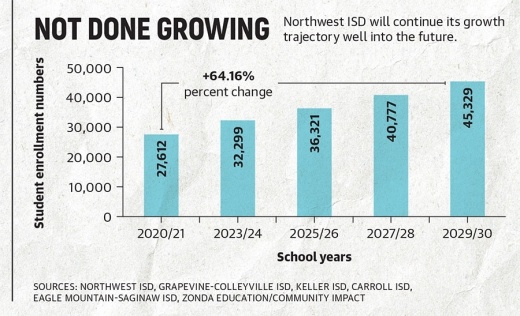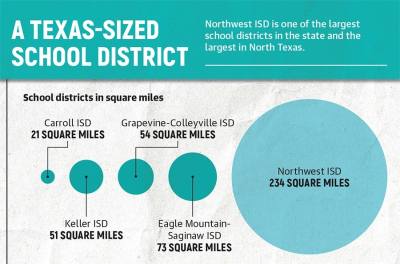Six new buildings were part of NISD’s bond package in 2021. That provided funds for school facilities and capital improvements totaling more than $712.4 million, while the remaining $25.1 million went to technology updates and recreation facility renovations. Four elementary schools will receive facility improvements and Gene Pike Middle School in Fort Worth could open by the 2024-25 school year.
Bob Templeton, vice president of school district segment for Zonda Education, was clear about the impending growth the Northwest ISD board will see during a Jan. 9 presentation.
“You are going to be experiencing the fastest growth of any districts in the Dallas-Fort Worth region,” he said.
Student enrollment ballooned from 15,036 in 2010 to 25,399 in 2020, according to the district website. NISD began the 2022-23 academic year with more than 28,600 students and is projected to end the school year with more than 30,000.
In addition to being the fastest-growing school district in the region, NISD is also one of the largest in terms of distance. At 234 square miles, NISD encompasses more than four times the area districts, such as Keller ISD at 51 square miles and Grapevine-Colleyville ISD at 54 square miles, do. Neighboring district Denton ISD contains all or parts of 18 cities, communities or major developments, but only encompasses 186 square miles.
The NISD board of trustees has been aware of the significant growth in its district for several years. After a bond package of nearly $1 billion was rejected by voters in November 2020, 35 projects representing more than $240 million in cost reductions were removed, and a new $745.7 million bond was presented to voters in 2021. Voters approved three out of the four proposals in the bond package. The three proposals gave the district $737.5 million to make school facility and capital improvements, build new middle school recreational facilities, and purchase new technology devices.
Capital improvements include constructing two new elementary schools and one new middle school, and replacing W.R Hatfield Elementary School and Gene Pike Middle School, each in Justin; making land acquisition for new schools; and purchasing new buses. Facility improvements include adding Pre-K classrooms with restrooms that meet state-mandated full-day Pre-K requirements, and adding access controls and new security cameras at Kay Granger Elementary School in Fort Worth, O.A. Peterson Elementary School in Fort Worth and Roanoke Elementary School in Roanoke.
Growth has been a long-term theme for NISD, and the district has been trying to keep up by passing several bond packages over the years, including $224.5 million in 2005, $260 million in 2008, $255 million in 2012, and $399 million in 2017.
While the 2021 bond package includes projects designed to accommodate nearly 5,000 new students over the next three to four years, Templeton expects NISD’s enrollment to grow to 38,400 by the 2026-27 academic year and to more than 49,800 students by the 2031-32 academic year.
According to Zonda Education, student enrollment increased 29.9% during the five years between the 2012-13 and the 2017-18 school years. Growth during that same time period for KISD and GCISD was 4.7% and 4.4%, respectively. NISD is also the No. 1 school district in Dallas-Fort Worth based on annual real estate closings, according to Zonda Education.
“These are record-breaking numbers,” Templeton said. “They are slowing, but it’s not going to keep us out of that record territory even with the slowdown.”
To accommodate the staggering growth rate in Northwest ISD, the Long Range Planning Committee recommended the district add a $1.995 billion bond for new facilities, renovations, technology and other needs. The ballot issue will be decided Feb. 13.
Several members of the LRPC spoke as part of their presentation to the board of trustees on Jan. 23. The LRPC was formed in 2000. It is comprised of parents, staff, community members and business leaders that represent a cross-section of the district and provide various perspectives from the community. The 57-member committee meets twice annually to review growth, enrollment projections, and facility needs.






